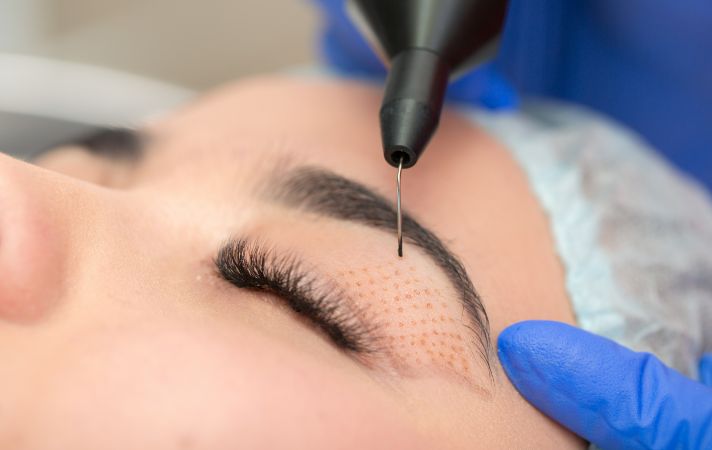As you age your body begins to change. This is especially true for the area surrounding your eyes.
There can be a build-up of fat around the eyes as you get older, or they can become more hollow.
In this post, we’ll explore the ins and outs of blepharoplasty, a procedure used in cosmetic surgery to reduce the effects of ageing around your eye area.
Whether you’re looking to address drooping eyelids, under-eye bags, or simply achieve a more youthful look, blepharoplasty offers a tailored solution to enhance your facial aesthetics.
Let’s get into it.
What is Blepharoplasty?
Blepharoplasty, commonly known as eyelid surgery, is a cosmetic or medical procedure designed to improve the appearance and function of the eyelids.
It involves the removal or repositioning of excess skin, muscle, and fat from the upper or lower eyelids, resulting in a more youthful and refreshed look.
This procedure can address issues such as droopy eyelids, bags under the eyes, and vision impairment caused by sagging skin.
Types of Blepharoplasty
There are several types of blepharoplasty, each designed to address specific concerns or areas of the eyelids. Here are the main types:
Upper Blepharoplasty
This procedure focuses on the upper eyelids and is typically performed to correct drooping or sagging skin that can impair vision or create a tired appearance.
It involves the removal of excess skin, muscle, and sometimes fat from the upper eyelids.
Lower Blepharoplasty
Lower blepharoplasty targets the lower eyelids and is primarily performed to address issues such as puffiness, bags under the eyes, and wrinkles.
The procedure can involve the removal or repositioning of fat, and sometimes the tightening of the skin and muscle.

Double Eyelid Surgery (Asian Blepharoplasty)
This type of blepharoplasty is popular among individuals of East Asian descent and aims to create a defined crease in the upper eyelid.
It can involve the removal or repositioning of tissue to create a double eyelid fold, enhancing the appearance of the eyes.
Transconjunctival Blepharoplasty
In this procedure, incisions are made on the inside of the lower eyelid, making them invisible from the outside.
It is typically used to remove or reposition fat without the need to remove excess skin, suitable for patients with good skin elasticity.
Revision Blepharoplasty
Revision blepharoplasty is performed to correct or improve the results of a previous eyelid surgery.
This can address issues such as asymmetry, overcorrection, under-correction, or scarring from the initial procedure.
Functional Blepharoplasty
Unlike cosmetic blepharoplasty, functional blepharoplasty is performed to improve the patient’s vision by removing drooping skin that obstructs the visual field.
It is often covered by insurance if deemed medically necessary.
Laser Blepharoplasty
Laser blepharoplasty uses a laser instead of a scalpel to make incisions.
The laser can help to reduce bleeding and bruising and may promote faster healing. It can be used for both upper and lower eyelid procedures.
Endoscopic Brow Lift with Blepharoplasty
This combination procedure addresses both the upper eyelids and the brow area.
An endoscopic brow lift raises sagging brows, while the blepharoplasty removes excess skin and fat from the upper eyelids, providing a more comprehensive rejuvenation of the upper face.
The Blepharoplasty Procedure
Pre-surgery Consultation and Evaluation
During this session we evaluate your medical history, discuss your aesthetic goals, and perform a detailed examination of the eyelid region.
This evaluation helps determine the procedure’s suitability and identify any potential risks or complications.
Your surgeon will also discuss the different types of blepharoplasty (upper, lower, or both) and what each entails, helping you to set realistic expectations.
Preparation Steps Before the Surgery
Prior to the surgery, you will receive specific instructions to prepare for the procedure.
This may include guidelines on medications to avoid (such as blood thinners and certain supplements), smoking cessation, and arranging for someone to drive you home post-surgery.
You may also be advised to undergo certain preoperative tests and to follow a skincare regimen to ensure optimal skin health.
It’s important to avoid eating or drinking anything after midnight on the day before surgery to prepare for anaesthesia.
The Surgical Process
Step 1: Anaesthesia
The procedure typically begins with the administration of anaesthesia to ensure your comfort throughout the surgery.
This can be either local anaesthesia with sedation, where you’re awake but relaxed, or general anaesthesia, where you’re completely asleep.
Step 2: Incision Techniques
Depending on whether the surgery is for the upper eyelids, lower eyelids, or both, the surgeon will make precise incisions.
For upper blepharoplasty, incisions are usually made within the natural crease of the upper eyelid.
For lower blepharoplasty, incisions may be made just below the lower lash line or inside the lower eyelid (transconjunctival incision).
Step 3: Removal or Repositioning of Fat and Skin
Through these incisions, the surgeon will remove or reposition excess fat deposits, skin, and sometimes muscle.
In upper eyelid surgery, this helps to correct sagging and improve the contour of the eyelid. In lower eyelid surgery, it addresses the puffiness and bags under the eyes.
The goal is to create a more youthful and refreshed appearance while maintaining natural eyelid function.
Step 4: Closing the Incisions
After the necessary adjustments are made, the surgeon carefully closes the incisions with fine sutures, surgical glue, or skin adhesives.
This helps to minimise scarring and ensure a smooth healing process.
In some cases, the sutures are designed to dissolve on their own, while in others, they may need to be removed during a follow-up visit.

How Long Does it Take to Recover from Blepharoplasty?
Recovery from blepharoplasty generally spans a few weeks to several months, with a noticeable improvement in the early stages and gradual refinement over time.
In the first few days post-surgery, you may experience the most significant swelling and bruising, which can be managed with cold compresses and head elevation.
Sutures, if used, are usually removed within a week.
Most patients feel comfortable resuming normal activities and returning to work within 1-2 weeks, although strenuous activities should be avoided for at least a month.
Full recovery, where residual swelling diminishes and incision lines fade, can take up to six months.
Throughout this period, follow-up appointments with the surgeon ensure proper healing and optimal results.
What are the risks of Blepharoplasty?
As with any surgical procedure, blepharoplasty comes with its set of potential risks and complications.
Understanding these risks helps you make informed decisions and take necessary precautions. These risks include:
- Infection – Post-surgical infections are a concern with any surgery, including blepharoplasty. Signs of infection include increased redness, swelling, pain, and discharge at the incision sites.
- Scarring – While surgeons make incisions in natural creases to minimise visible scarring, some patients may still develop noticeable scars. The extent of scarring can vary depending on individual healing processes and skin types.
- Dry Eyes – After blepharoplasty, you may experience dryness, irritation, or a gritty sensation in your eyes. This is often temporary and can be managed with lubricating eye drops, but in rare cases, it can persist and require further treatment.
- Asymmetry – Achieving perfect symmetry in facial surgery can be challenging. There is a risk of slight asymmetry where one eyelid may appear different from the other in shape or size. This may necessitate additional procedures to correct.
Your Next Blepharoplasty Surgeon
We hope this comprehensive guide has provided valuable insights into blepharoplasty and how it can enhance your natural beauty.
At the New Birkdale Clinic, our commitment to excellence ensures that every patient receives personalised care tailored to their unique needs and goals.
If you’re considering blepharoplasty or have any further questions, our experienced team is here to guide you every step of the way.
Contact us today to schedule a consultation and take the first step towards a refreshed and rejuvenated appearance.
